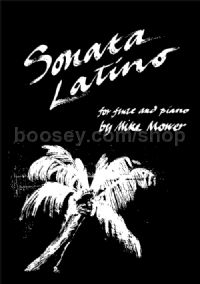Sonata Latino for flute & piano
Sonata Latino for flute & piano
* Estimated price converted from UK retail price
A specially commissioned work in three movements for flute and piano. Each movement is in the musical style of a different Latin American country incorporating Salsa, Merengue, Rumba, Tango and Bossa Nova. Already a popular repertoire work, Sonata Latino was recently featured and analysed in a 5 page article in Flute Talk magazine. Optional parts are available for performance with flute and salsa band as recorded by James Galway. Comprises flute, 2 trumpets, trombone, alto, tennor, baritone, saxophones, piano, bass guitar, drums, 2/3 percussion. M-708010 32 6 Excerpts from "Tango Del Fuego" RCA 0906-63422-2 James Galway, produced & arranged by Mike Mower.
Programme Notes
Sonata Latino was written in October 1994 for Kirsten Spratt and Elizabeth Mucha. They asked for a piece in South American style so I wrote this sonata incorporating various Latin rhythms. It is not intended to be a purist representation of the idiom, but to sound how a contemporary latin/jazz improvising duo might play at a gig. I hoped to capture something of the personality of each country in the music. Although I have no Latin roots, I've loved the music for years and have been lucky enough to tour South America a few times with my Saxophone Quartet Itchy Fingers.
Salsa Montunate As the title suggests, draws from the Cuban/Venezuelan Salsa. The piece starts with the flute laying down a 2-3 Clave which turns into a Montuno riff. The piano picks up the Montuno whilst playing the off-beat bass line or Tumbao and this is the basic groove for the movement. After the main theme, the flute and piano "trade fours" and play a rhythmic percussive section based on the original Clave rhythm.
Rumbango You've guessed it - a mixture of Rumba and Tango type rhythms, as found in Columbia and Argentina. The piece starts with a flute cadenza which states the somewhat darker tone for this movement . I wanted to give the feel of the flute being aloof and independent from the rhythmic piano riff. The movement gradually builds through a lighter Rumba - type section to a manic, angst - ridden waltz with the pianist physically attacking the keyboard at one point!
Bossa Merengova This borrows from the more recent Bossa Nova hybrid rhythms from Brazil. I treated this movement more as a jazz player might do with "improvised solo" sections for both flute and piano. The piano writing is looser and more harmonically jazz-oriented, but in places moves into double - octave arpeggio licks evoking the Merengue style popular in Venezuela and Columbia. A coda section then returns to a salsa "turn-around" riff reminiscent of the Cuban - influenced first movement.



